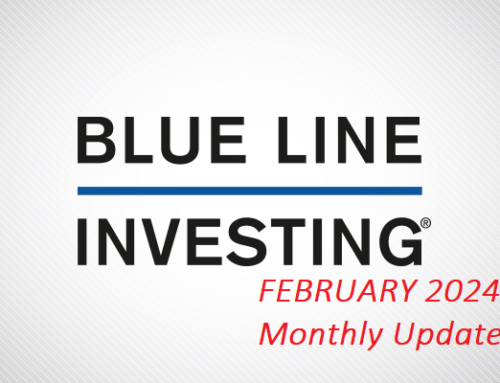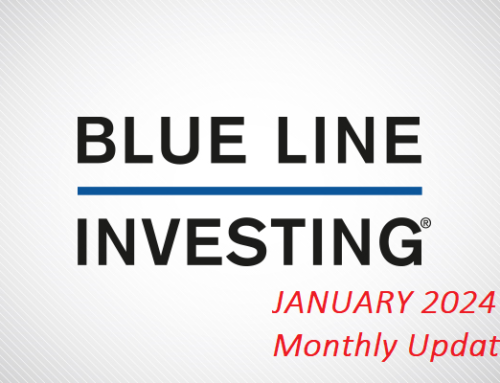After recently passing the half way point of the calendar year, the US stock market has so far provided low, single-digit returns. So, what might investors expect for the second half of the year? More of the same or something different? While no one has a crystal ball I have found technical analysis to be a helpful tool to set my expectations. The chart below, in my opinion, provides two important items for investors to pay attention to at present.

Chart courtesy of StockCharts.com
First, the stock market may be on the verge of making a trend decision. There are two patterns that can be identified on the weekly chart above – a consolidating channel and a rising channel. The consolidation channel labeled “1A” and “1B” illustrates a period when stock prices remained range bound and stagnated. Such was the case from late 2014 through early 2016. This pattern eventually became a rising channel labeled “2A” and “2B.” Such a channel illustrates a period when prices rise higher and higher over time. But now we see the potential for a new consolidation channel labeled “3A” and “3B” forming inside the rising channel. So how can you determine which of the two is the dominant channel right now? Based on the chart it appears the US stock market is at a crossroads. If price rises decisively above line “3A” we believe it is likely the rising channel will continue with higher prices to come. But if prices decline decisively, possibly below line “2B,” it is likely a consolidation channel will continue, with stagnant prices for the foreseeable future.
Second, on each of the stock rallies since February, the relative strength indicator has topped at 60. This can be observed with labels 4A and 4B, 5A and 5B, and 6A and 6B. Historically speaking, I have found that relative strength tends to top out at 60 during consolidation channels, as well as with negative primary trends. Price does not typically continue in a rising channel with relative strength remaining at or below 60.
You may be wondering how this information can be beneficial. The answer has to do with money you already have invested versus money you may be considering investing. For money already invested, this information sets the expectation that prices are likely to consolidate or continue to rise for the foreseeable future. If that is your expectation there is likely no need to hedge or sell any investments over fear of a stock market downturn. For money being considered for investment, the outcome determines a purchase decision. If price decisively rises above line “3A” it could be advantageous to buy. However, if price declines decisively below line “3A” it could signal to delay new purchases, as lower prices may result in the near-term. Whatever happens over the coming days and weeks, the relationship between price and relative strength should help identify which of the two trend channels is dominant at this time.
Jeff Link
Disclaimers:
¹ Blue Line Investing (BLI) is an alternative to traditional wealth management. BLI uses a disciplined, rules-based investment process to seek investment opportunities, regardless of whether financial markets are rising or falling. Based on technical analysis research, the process applies trend-following using specific Exponential Moving Averages (EMAs) of the market along with other technical indicators. A moving average is a widely used indicator in technical analysis that helps smooth out past price action by filtering out the “noise” from random price fluctuations. EMA’s can be calculated for any time period. Some examples include the 5 day EMA; 50 day EMA; and 150 day EMA. We have attempted to simplify this by calling the various EMAs we use in our process the “Blue”, “Purple” and “Green” lines.
² The S&P 500 Index is one of the most commonly followed equity indices, and many consider it one of the best representations of the U.S. stock market, and a bellwether for the U.S. economy. It is comprised of 500 large companies having common stock listed on the NYSE or NASDAQ. The volatility (beta) of the account may be greater or less than the index. It is not possible to invest directly in this index.
Technical analysis is a method of evaluating securities by analyzing statistics generated by market activity, such as past prices and volumes. Technical analysis attempts to predict a future stock price or direction based on market trends. The assumption is that the market follows discernible patterns and if these patterns can be identified then a prediction can be made. The risk is that markets may not always follow patterns. There are certain limitations to technical analysis research, such as the calculation results being impacted by changes in security price during periods of market volatility. Technical analysis is one of many indicators that may be used to analyze market data for investing purposes and should not be considered a guaranteed prediction of market activity. The opinions expressed are those of Blue Line Investing. The opinions referenced are as of the date of publication and are subject to change without notice. Blue Line Investing reserves the right to modify its current investment strategies based on changing market dynamics or client needs.
The relative strength measure is based on historical information and should not be considered a guaranteed prediction of market activity. It is one of many indicators that may be used to analyze market data for investing purposes. The relative strength measure has certain limitations such as the calculation results being impacted by an extreme change in a security price.
Past performance is not indicative of future results. This material is not financial advice or an offer to sell any product. The information contained herein should not be considered a recommendation to purchase or sell any particular security. This information is intended for educational purposes only and should not be considered financial advice. It should not be assumed that the investment recommendations or decisions we make in the future will be profitable or will equal the investment performance of the securities discussed herein. Forward looking statements cannot be guaranteed.
Advisory services offered through Gordon Asset Management, LLC (GAM). GAM is an SEC-registered investment adviser. Registration does not imply a certain level or skill or training. More information about the advisor, its investment strategies and objectives, is included in the firm’s Form ADV Part 2, which can be obtained, at no charge, by calling (866) 216-1920. The principle office of Gordon Asset Management, LLC is located at 1007 Slater Road, Suite 200, Durham, North Carolina, 27703.




